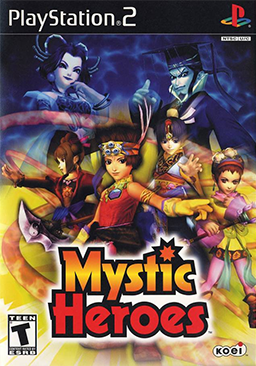Mystic Heroes
This article needs additional citations for verification. (December 2008) |
| Mystic Heroes | |
|---|---|
 North American cover art for PlayStation 2 | |
| Developer(s) | Koei |
| Publisher(s) | Koei |
| Platform(s) | GameCube, PlayStation 2, Game Boy Advance |
| Release | GameCube Game Boy Advance PlayStation 2 |
| Genre(s) | Beat 'em up |
| Mode(s) | Single-player, multiplayer (up to 4 players) |
Mystic Heroes, released in Japan as Battle Houshin (バトル封神), is a beat 'em up video game developed by Koei. The game is based on Fengshen Yanyi, a supernatural Chinese novel about the fall of the Shang Dynasty and the rise of the Zhou Dynasty.
Mystic Heroes was released for the Nintendo GameCube on March 29, 2002 in Japan, September 30 in North America, and December 13 in Europe. A Game Boy Advance version was released simultaneously with the GameCube version exclusively to Japan. A PlayStation 2 version was released November 16, 2002 in Japan and November 24 in Europe and America. The PlayStation 2 version features additional characters and gameplay modes.
Gameplay
Mystic Heroes is a fighting action game, similar to Koei's Dynasty Warriors. Players can perform melee attacks and element spells, which become more powerful with continuous use. The game has eight stages.
There are four playable characters, and four unlockable characters in the PS2 version, for a total of eight. The game features a single-player story mode and three additional single-player modes, as well as co-op and versus multiplayer.
Plot
Long ago in a legendary land, Emperor Kang and his wife Sheva ruled with an iron fist. Tai and Naja, two elite mystics, sealed them away in Mt. Houshin, thus restoring peace. But Kang's son, Cyrus, built up an army to battle the mystics in an attempt to free his father. At this time two more mystics, Shiga and Lani, joined the fight alongside Tai and Naja. The four mystics along with their friends once again saved the land and returned the peace. Now Emperor Kang, Sheva, and Generals Grifon and Kai start to plan their escape. Grifon brings up the existence of something known as the "Dragon Star", which could free them. So Kang calls upon the powers of the Dragon Star, and he along with all of his minions are set free, giving Kang the chance to rise once again to dominate the land. This game takes place after Houshin Engi, Magical Houshin (this game takes place after the first title) and Houshin Engi 2.
The player can choose to play as Tai, Shiga, Lani, or Naja.
Reception
| Aggregator | Score |
|---|---|
| GameRankings | (GC) 69.50%[1] (PS2) 62.75%[2] |
| Metacritic | (GC) 67/100[3] (PS2) 67/100[4] |
| Publication | Score |
|---|---|
| Edge | 7/10[5] |
| Electronic Gaming Monthly | 5.5/10[6] |
| Famitsu | (GC) 33/40[7] (PS2) 32/40[8] |
| Game Informer | 7.75/10[9] |
| GamePro | |
| GameSpot | 7.3/10[12][13] |
| GameSpy | |
| IGN | (PS2) 7/10[15] (GC) 6.3/10[16] |
| Nintendo Power | 3.6/5[17] |
| Official U.S. PlayStation Magazine |
Mystic Heroes was met with average to mixed reception upon release. GameRankings and Metacritic gave it a score of 69.50% and 67 out of 100 for the GameCube version,[1][3] and 62.75% and 67 out of 100 for the PlayStation 2 version.[2][4]
In Japan, Famitsu gave the game a score of 33 out of 40 for the GameCube version,[7] and 32 out of 40 for the PS2 version.[8]
References
- ^ a b "Mystic Heroes for GameCube". GameRankings. Retrieved August 12, 2014.
- ^ a b "Mystic Heroes for PlayStation 2". GameRankings. Retrieved August 12, 2014.
- ^ a b "Mystic Heroes for GameCube Reviews". Metacritic. Retrieved August 12, 2014.
- ^ a b "Mystic Heroes for PlayStation 2 Reviews". Metacritic. Retrieved August 12, 2014.
- ^ Edge staff (December 25, 2002). "Mystic Heroes (GC)". Edge (118). Archived from the original on January 21, 2003. Retrieved August 13, 2014.
{{cite journal}}: Unknown parameter|deadurl=ignored (|url-status=suggested) (help) - ^ Trais, Jeanne (October 2002). "Mystic Heroes (GC)". Electronic Gaming Monthly: 94. Archived from the original on April 27, 2004. Retrieved August 13, 2014.
{{cite journal}}: Unknown parameter|deadurl=ignored (|url-status=suggested) (help) - ^ a b "ニンテンドーゲームキューブ - バトル封神 (GC)". Famitsu. 915: 98. June 30, 2006.
- ^ a b "ニンテンドーゲームキューブ - バトル封神 (PS2)". Famitsu. 915: 82. June 30, 2006.
- ^ Kato, Matthew (October 2002). "Mystic Heroes (GC)". Game Informer (114): 86. Archived from the original on February 24, 2007. Retrieved August 12, 2014.
{{cite journal}}: Unknown parameter|deadurl=ignored (|url-status=suggested) (help) - ^ Star Dingo (September 24, 2002). "Mystic Heroes Review for GameCube on GamePro.com". GamePro. Archived from the original on February 8, 2005. Retrieved August 13, 2014.
{{cite web}}: Italic or bold markup not allowed in:|publisher=(help); Unknown parameter|deadurl=ignored (|url-status=suggested) (help) - ^ Four-Eyed Dragon (December 3, 2002). "Mystic Heroes Review for PS2 on GamePro.com". GamePro. Archived from the original on February 12, 2005. Retrieved August 13, 2014.
{{cite web}}: Italic or bold markup not allowed in:|publisher=(help); Unknown parameter|deadurl=ignored (|url-status=suggested) (help) - ^ Gallant, Matthew (October 9, 2002). "Mystic Heroes Review (GC)". GameSpot. Retrieved August 12, 2014.
- ^ Gallant, Matthew (December 2, 2002). "Mystic Heroes Review (PS2)". GameSpot. Retrieved August 12, 2014.
- ^ Steinberg, Scott (January 19, 2003). "GameSpy: Mystic Heroes (PS2)". GameSpy. Retrieved August 13, 2014.
- ^ Ng, Stephen (November 25, 2002). "Mystic Heroes (PS2)". IGN. Retrieved August 12, 2014.
- ^ Mirabella III, Fran (October 10, 2002). "Mystic Heroes (GCN)". IGN. Retrieved August 12, 2014.
- ^ "Mystic Heroes". Nintendo Power. 160: 164. September 2002.
- ^ Baker, Chris (January 2003). "Mystic Heroes". Official U.S. PlayStation Magazine: 108. Archived from the original on May 25, 2004. Retrieved August 13, 2014.
{{cite journal}}: Unknown parameter|deadurl=ignored (|url-status=suggested) (help)
External links
- Mystic Heroes official site
- Mystic Heroes (GameCube) at MobyGames
- Mystic Heroes (PlayStation 2) at MobyGames
